Chapter: Aquaculture Principles and Practices: Health and Diseases
Integrated health management - Health and diseases in aquaculture
Integrated health management
At the beginning, the relevance of a concept of integrated health management in aquaculture was referred to. The discussion of the factors affecting fish health underline the need for such an approach to reduce levels of risk and accelerate the development of the emerging aquaculture industry. Such a management programme that involves (i) the implementation of appropriately planned guidelines for prevention, control and eradication of diseases, (ii) correction of disease-causing and disease-spreading conditions in farms and (iii) the adoption and implementation of policies and regulations by the State requires a high degree of cooperative effort. In its basic phi-losophy and approach, such a programme may not be very different from the integrated pest control programmes in agriculture, which are in operation in many countries. The basic difference would appear to be the infancy of the science, lack of proper organization of the aquaculture industry and some of the complications caused by the watery medium in which aquaculture crops are raised.
In integrated pest management, all classes of pests and their interrelationships are considered together and the protection of the crop is seen as an important element in the overall management of an agro-ecosystem. It extends the concept of integrated control as a combination of all available management techniques, implying the coordination of relevant control measures into a unified pro gramme which seeks optimal control. In practice, this means using appropriate techniques to keep disease agents below a certain level that causes an unacceptable economic loss. Selection of species and strains, immunization, environmental manipulation, nutrition and chemotherapy are techniques that are used for this purpose. However, there comes a point when the economic threshold of disease control has been reached and further efforts to control or eliminate the pathogens will not compensate the cost involved in terms of the benefits derived. Exceptions would be diseases that have to be eradicated under any circumstances, at any cost, due to dangers involved not only to the individual farms concerned but also to others in the industry and community.
In planning fish health management measures, a distinction has to be made between the control of obligate pathogens, which affect only the particular species under culture, and infectious diseases caused by facultative (opportunistic) pathogens usually present in the environment. The control of obligate pathogens is based on identifying the sources of infection, breaking the connection between such sources and susceptible aquaculture stocks and reducing the susceptibility of the exposed stocks. A broader strategy that integrates all the available management techniques is required for the control of diseases caused by facultative pathogens. The economic threshold for diseases caused by facultative pathogens is often difficult to determine. It can be done only on the basis of experience in assessing the economic impact of a disease and an understanding of the merits of additional control measures that can be adopted.
Prevention can be considered as the cornerstone of a health protection programme, but is often more complex than the control of an existing disease. This would involve a reliable identification of the disease and its carriers, adequate knowledge of the transmission mechanisms, the development of effective methods of preventing the access of pathogens and their carriers into culture facilities and the provision of environmental conditions conducive to the maintenance of a healthy condition among culture species.
Health inspection and disease monitoring
Timely information on the health status of aquaculture stock and the environmental conditions is essential for an effective disease control programme. Such information will enable a quick response to disease outbreaks and reduce the mortality rate in infected stock by the provision of prompt therapy. If the disease problem is attributable to poor management, immediate corrective measures can be undertaken. When necessary, appropriate steps can be taken to prevent the introduction of disease agents from outside sources through transfer of eggs or adults or exposure to other contaminated sources.
Ideally, every large aquaculture enterprise should have at least one trained person and the basic facilities to undertake regular health and environmental monitoring of the farm. Prompt on-site diagnosis of disease permits the immediate application of chemotherapy or remedial measures to control or eradicate the disease. Where such on-site diagnosis is not feasible due to economic reasons or lack of trained personnel, a cooperative or State-organized system of health inspection would be a possible alternative. A competent person should inspect the facilities at regular intervals and gather the relevant information. The minimum number of inspections required is suggested as twice a year. The inspection should be conducted using procedures that will detect the presence of parasitic, viral and bacterial pathogens. Samples of all lots of stock in the farm should be inspected.
A sample is recommended to contain 60 individuals of each lot, except in the case of brood stock where the number may have to be reduced. The inspector should have access to laboratory facilities to study the samples in as detailed a manner as is necessary. For the identification of viral agents or viral diseases, the facilities of a laboratory that maintains tissue culture and specific antisera will be needed. Collection and preservation of specimens for detailed examination will have to be done as required by the diagnostic laboratories. In situations where a viral epizootic is suspected, only a relatively few specimens (between 15 and 20) exhibiting the typical symptoms will be required for examination.
The value of organized health inspection and disease monitoring is manifold, despite the costs involved. By detecting predisposing conditions for an outbreak of disease in advance, preventive actions can be taken and unnecessary losses avoided. Infections diagnosed in the early stages can more easily be treated. It may also be possible to isolate infected individuals from the stock and prevent spread of the disease to others in the same farm or neighbouring farms.
As will be discussed later, the control of communicable diseases of aquaculture species, nationally as well as internationally, will have to be based on legislative regulations that require appropriate reporting procedures and certification at source of stock and eggs, for freedom from infection, by competent personnel. A regular health inspection of the farm may also enhance its acceptability for participation in a risk-insurance programme.
Eradication of a disease by chemotherapy or the use of therapeutants gives only temporary relief, and may cause a negative effect by resulting in undesirable or harmful residues in cultured animals. White spot syndrome virus (WSSV) has been confirmed in at least nine countries in Asia-Pacific, with a global loss to aquaculture production, according to the World Bank estimate in 1997, in the range of US $3 billion per annum. Epizootic ulcerative syndrome (EUS), which is treated by antifungus therapeutants, caused a loss in most southeast and south Asian countries of US $100 million.
Use of antibiotics increased in salmon and trout production in Norway, with the result that drug treatment became ineffective against the pathogen until vaccines became commercially available. Since the 1960s several vaccines have been developed, providing a cost-effective method of controlling certain infectious diseases. Vaccines are now commercially available for many finfish diseases, e.g., enteric red mouth (Yessiana ruckeri), furunculosis (Aeromonassalmonicida), cold water vibriosis or Hitradisease (Vibrio salmoninarum), Vibrioangullarum serotype 01 and 02, V. ordalli, Photobacterium (Pasteurella) damsela subsp. piscicida, Streptococcus sp., I.P.N. etc. By reducingthe severity of losses in production, vaccines also reduce the need for antibiotics; they leave no residues in the product and do not cause pathogen resistance. While commercial vaccination has proved effective in protecting against certain diseases of finfish, vaccination is not possible against shrimp and molluscan pathogens.
Disease surveillance and regular monitoring has been recommended earlier as an effective method of disease prevention and control. One must recognize its limitations, however, in terms of pathogen groups and complicated health management by triggering toxicity and residues and public health and environmental consequences. For example, drug overdoses can cause fish kills and detrimental side effects, such as gill damage caused by repeated treatments of potassium permanganate in marine conditions.
As mentioned before, chemotherapy will have to be adopted for prophylaxis and control in the foreseeable future, though there is considerable recognition of its limitations.
Subasinghe et al. (2001) point out that research to manage many health problems have progressed over the last 30 to 40 years, but new issues have arisen for aquaculture during this period. It is accepted that there is no more cost-effective method of management available than regular competent inspection, supported by legislative measures based on scientific research into suitable screening and detection methods for sub-clinical carriers.
These methods are currently used in the screening/diagnosis of many significant patho-gens of cultured finfish, e.g., channel catfish virus (CCV), infectious pancreatic necrosis (IHNV), infectious hematopoetic necrosis virus (IPNV), viral haemorrhagic septicaemia virus (VHSV), viral nervous necrosis virus (VNN) and bacterial kidney disease (BKD), as well as shrimp diseases (e.g. WSSV, YHV) and taura syndrome virus (TSV). The molecular-based techniques provide quick results with high sensitivity at relatively low cost and are particularly valuable for infections that are difficult to detect, including sub-clinical infections.
Diagnostic determination of the cause of a disease can be a highly technical biomolecular-based process for penaeid shrimp diseases and molluscan pathogens. Molecular tools are also useful in research into the pathology and
immunology of infections. Establishment of national disease surveillance and reporting systems may be used for regional or international reporting of effective strategies for disease control. This serves as a basis for instituting control and eradication program-mes, as well as early warning and emergency preparedness.
The Fish Disease Commission of the Office International des Epizooties (OIE) developed recommendations and protocols for internationally traded animals. This has been discussed in relation to the reduction of risks associated with the introduction of species, especially exotic species of relevance to aquaculture. OIE lists 25 diseases of finfish, molluscs and crustaceans, which fit the criteria of the OIE as being of significant importance (OIE, 2000a) once a year, and if found necessary these are published more often to member governments. A brief summary of information on the causative agents of the diseases that are of potential international significance is included in the reports. In international trade, records of reportable diseases allow sovereign states to determine the quarantine and preventive action that can be taken to protect animals under culture from the risk of pathogens and the spread of disease. Legislative and policy frameworks and institutional requirements have to be met from the resources made available to the industry. Introduction of new species into new areas will require evaluation of scientific evidence regarding the risk of introducing pathogens to new areas. Conscientious and transparent reporting is required for effective health management. Regional cooperation in health management has to be planned in a way that the benefits are shared among all the stakeholders.
It has to be remembered that the OIE list of reportable diseases is not exhaustive. Many more pathogenic diseases of regional or national importance that have significant impact on aquaculture productivity remain unreported. Some of them are well researched, while others are of unknown aetiology or newly emergent.
In addition to these reported diseases, many more diseases of regional and national interest have significant importance on aquaculture productivity. These diseases can be a challengeto aquaculture development in certain regions. For example, mass mortality has occurred in cultured sea-bass (Dicentrarchus labrax and Lates spp.) and groupers (Epinephelus spp.)due to several viral diseases. ‘Red spot disease’ has affected grass carp (Ctenopharygodonidellus) and epizootic ulcerative syndrome(EUS) has caused mass mortality of both wild and cultured fish. So livestock may still need protection from certain other reportable disease agents that do not appear on the OIE list.
Disease treatment
The eradication of disease requires a programme that will remove infected stocks, prevent reinfection, reduce stress and maintain optimal conditions. Chemotherapy or the use of therapeutants generally gives only a temporary advantage over pathogens. If conditions are not improved, disease can recur when the animal becomes susceptible to infection.
Chemical treatment to prevent disease may have the effect of reducing or eliminating pathogens. However, such treatment may also have negative effects on biological filters in controlled recirculating systems, and may adversely affect algae in the culture system, besides leaving undesirable or harmful residues in cultured animals (Sindermann, 1986). The main drugs used for disease control in pond culture are listed in Tables 9.2 and 9.3. Most of them are in use in pond culture in former USSR, Canada, the USA and Europe. Some countries enforce restrictions on the use of chemicals to treat animal diseases. Most of the available information on chemotherapy is based on experience in freshwater pond fish culture. Salmon and trout culture in cages in Norway became so prevalent that the fish farming industry had taken to increasing use of antibiotics until vaccines were developed to control the spread of prevalent diseases. Most of the countries still rely on chemotherapy especially for the control of infectious microbial diseases of finfish; some farms employ the prophylactic use of chemicals and biologicals to activate the level of sanitation and to minimize diseases caused by opportunistic infectious agents through disinfection of hatchery equipment and water supply. During transportation, aquatic animals are most vulnerable to injury and physiological stress, and antibiotic treatment may have to be resorted to.
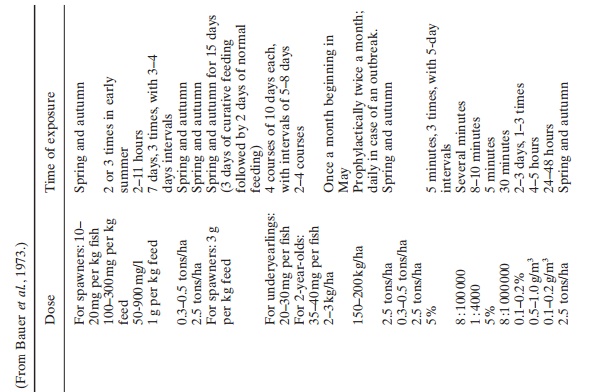
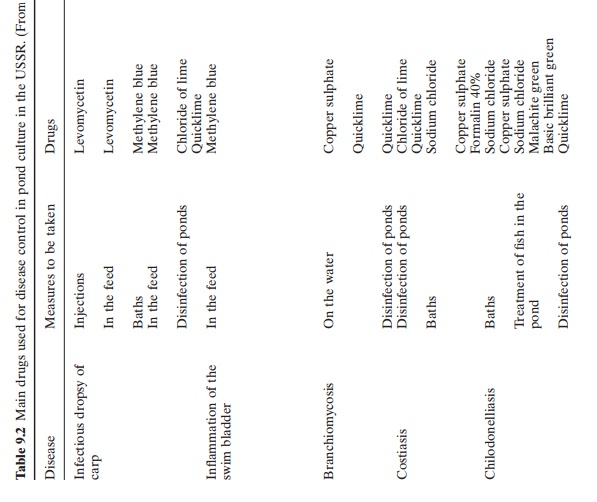
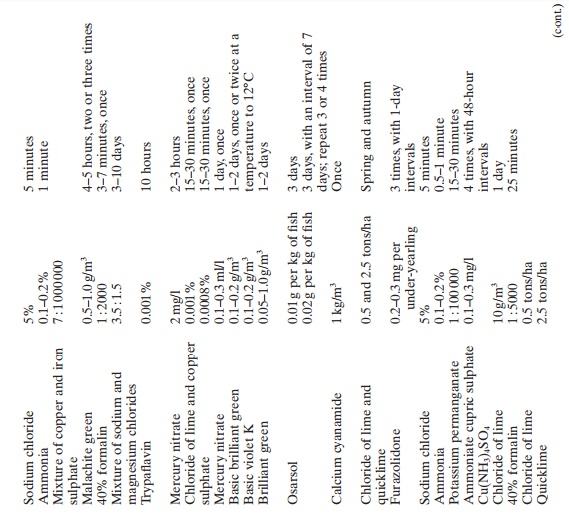
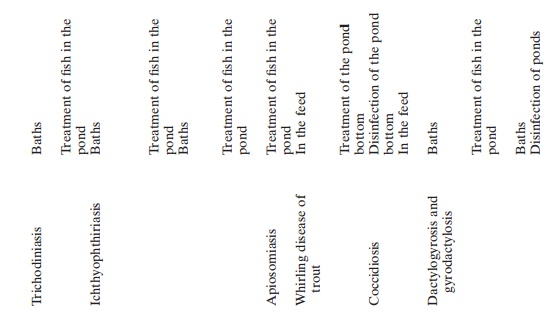
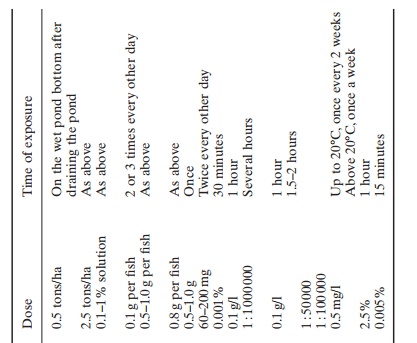

During the last few decades vaccination of the species used for aquaculture has become an effective practice for controlling certain infectious diseases in industrially developed countries. According to Subasinghe et al. (2001) vaccines are available now for a number of diseases of finfish, for example enteric red mouth (Yersinia ruckeri), Hitra disease (vibrio salmanarum), vibrio angullarum serotypes 01 and 02, Vibrio ordalli, Photobacterium (Pasteurella) damsela subsp., Piseida, Streptococcussp. and1PN. Many more are now under development such as Flavobacterium psychrophilum, Ranibacterium salmoninarum, IHN, VHS, infectioussalmon anaemia (ISA), VNN and Icthyophthir-ius mettafillis (‘Ich’). These vaccines help toreduce the use of antibiotics and avoid chemotherapeutant residues. Advances are reported in fish and shellfish immunological research on specific and non-specific defence mechanisms (Woo and Bruno, 1999).
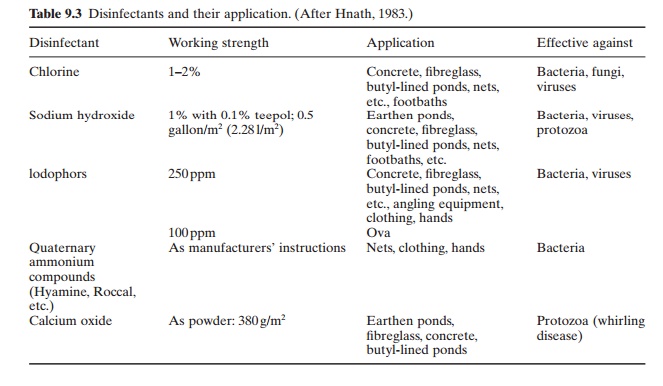
The chemical characteristics of the water supply in the farm will affect the toxicity and efficacy of chemotherapeutic treatment, and this has to be assessed before any large-scale treatment. It has been recommended that before use a chemical should be tested on a small number of sick animals. As the tolerance of sick animals to chemical treatment will often be less than that of healthy ones, it may become necessary to adjust treatment levels if they are weak or in poor condition. Before starting treatment it is necessary to ensure that the facilities are as clean as possible, because organic matter will absorb some of the treatment chemical and reduce its effectiveness. Reduction of stock density, suspension of feeding a day or two before treatment, monitoring of dissolved oxygen levels before and during treatment, sup-plemental aeration and treatment during the coolest part of the day are some of the other precautions suggested for effective treatment.
Continuous feeding of antibiotics at low levels in the diet as a prophylactic measure against outbreaks of bacterial disease is a practice that is discouraged. At such low levels, the antibiotic may serve only to kill those bacteria most sensitive to the drug, and lead to the development of drug-resistant strains. So antibiotic treatment should be done only when
Commercial medicated feeds, if available, are easy to use and in certain circumstances less expensive. Medicated feed can also be made on the farm. Suspending the drug in a suitable oil such as cod liver oil and coating the daily ration of feed pellets with the mixture of oil and drug in a mixer would be an easy way of making medicated feeds.
The local application of drugs and injections have limited use in disease control in aquaculture – bath and dip treatments are much more applicable and common. Dips of short duration, varying from a few seconds to five minutes, depending on the chemical and the concentration, are recommended for certain infections, especially of brood stocks. Though very effective, such treatment can be stressful. After treatment, the animal should be rinsed in clean water and released in water free from parasites and pathogens. Where fresh water is available and adequate oxygen levels can be maintained, baths of up to an hour’s duration can be given. High concentrations of chemicals can be used, but care has to be taken to avoid overdoses and over-long contact times.
In pond farms, lower concentrations of the chemical are usually used and allowed to dissipate in the ponds. Generally, the water level in the pond is lowered to reduce the amount of chemical to be used. There are, of course, possible risks to pond biota and oxygen levels. For example, the degradation of formalin uses up 1 ppm oxygen for each 5 ppm of formalin, and it acts as an algicide. In running water ponds and raceways, a system of flush treatment is possible. The required amount of the chemical is added at the inlet and allowed to flush through the pond or raceway.
Sanitation
The maintenance of sanitary conditions in an aquaculture facility is of the utmost importance in preventing the outbreak of disease. This is obviously very much tied in with sound culture practices and sometimes it becomes difficult to separate the two. Monitoring of the water supply is an effective and essential means of controlling diseases. Actual disinfection of supplies is often quite expensive and is generally possible only in hatcheries. Three acceptable methods of disinfection are recommended:ozonation, ultra-violet irradiation and chlorination. When a facility is affected by infectious diseases and the necessary treatment has been applied or the stock destroyed as the disease is incurable, disinfecting the facility and maintaining sanitary conditions on a continued basis are especially important.
The main goal of a sanitation programme is to prevent the spread of pathogens of cultured species. Egg disinfection strives to prevent the transmission of pathogen from the parent stock to the progeny and transfer from the hatchery to the rearing areas. Sanitary measures can help in confining pathogens of an infected stock to one part of the farm and prevent them from spreading infection to other parts.
The roles of health inspection and infection monitoring to prevent the spread of disease have already been referred to. When introduction or transplantation of aquaculture species is essential and proper certification of eggs, fry or adults to be transplanted, based on regular health inspection, is not available, it will be necessary to consider quarantine measures. This involves retention of newly imported stocks in quarantine facilities for prescribed periods to ascertain whether they are carriers of disease agents. Quarantining is most relevant when the main purpose is to prevent the introduction of communicable diseases that have never been recorded in a country or region. It has been used more widely in research situations, rather than in commercial farming, because of the need for sophisticated holding facilities with capabilities for total disinfection of effluents.
Quarantine facilities must be separated by physical barriers or located away from the farm. All effluents from the quarantine must be fully disinfected. Chlorination of effluents at 200 mg/l total chlorine for two hours is recommended. Lower concentrations may be effective in certain facilities, particularly if a longer exposure is used. These levels may apply only to small water volumes, as use on large volumes of water could represent serious environmental hazards. It is obvious that effective quarantine measures are relatively very expensive, and regulatory agencies often have difficulty in justifying such expenses against the economic benefits to be derived from the introduction or transplantations that can be regulated through these measures.
Immunization
A relatively new technique of disease prevention in fish is through immunization with vaccines. Licensed vaccines are now available against an increasing number of diseases. Though they do not give absolute protection from infection, they do help to combat infections, especially when the specific diseases cause repeated problems.
Protection from a disease is sought to be achieved through the development of specific resistance in the cultured organism to the causal agent. The mechanism of antibody production is a crucial element in such an acquired resistance. An antibody is a specific immunoglobulin (modified protein) which is produced in response to and reacts specifically with an antigen. An antigen is any foreign substance which is capable of stimulating the formation of antibodies and reacting with the produced antibodies, under suitable conditions. Vaccines or bacterins contain antigens that are generally attenuated or killed disease agents. When administered to a host, they stimulate the production of specific antibodies or non-specific resistance to that particular disease agent. The chances of survival of the host, when infected by the pathogen, are greatly enhanced by the immunization achieved through the production of antibodies. The immunological responses of fish are generally similar to those of terrestrial vertebrates, including phago-cytosis and the elaboration of specific immuno-globin antibodies. Prophylactic immunization of several species of fresh-water fishes has been attempted using this characteristic. Vaccination has been shown to be cost-effective in salmonid species that have a sensitive immune response system that can be stimulated by immunization. Attempts have also been made to immunize salt-water-held salmon against vibrio and other bacterial infections. It has, however, to be remembered that there are many other diseases of salmonids and other species for which vaccines have yet to be developed.
Vaccination can be done by a variety of methods, of which the most successful ones for fish immunization appear to be immersion/spray-shower vaccination and injection. Immersion is specially suited for small fish (1–
4 g), whereas spray-shower vaccination is more convenient for fish larger than 4 g. The immune response is affected by temperature conditions, higher temperatures contributing to a rise in specific antibody production. Under optimal conditions, it takes two to four weeks for protective immunity to develop after antigenic stimulation. A vaccinated fish can retain immunity for well in excess of 300 days, if temperatures are favourable. Immersion and spray-shower vaccinations have the advantages of rapid administration and cost-effectiveness.
Where it is specially needed, vaccination can also be done by injection. Intra-peritoneal injection is preferred because of the rapid development of protection and ease of administration.
Genetic resistance to disease
Based largely on experience in genetic breeding for disease resistance in agriculture, there is considerable optimism concerning the possibilities of developing strains of fish and other aquaculture animals that can resist certain infections. Fish are known to adapt to disease in nature and these traits of resistance can be measured experimentally. However, Warren (1983) pointed out some of the problems involved in the development of disease-resistant strains of fish, based on experience with salmonids. Brook trout strains, selected for their resistance to furunculosis, were reported to have acquired greater susceptibility to bacterial gill diseases during selection. Some strains of US West Coast steelhead trout resistant to bacterial kidney disease (BKD) were also the strains most susceptible to Vibrioanguillarum infections. It is suggested that theloss of genetic diversity in a selection process makes it difficult to develop strains of fish that are resistant to several diseases at the same time. In a programme of selection for disease resistance, survival after a challenge by the particular disease will have a high trait value. But the surviving disease-resistant animal may develop a carrier state. This is harmful, especially if the disease carrier is to be introduced into new areas where the disease would not otherwise occur. However, it is believed that by maintaining a high level of genetic diversity in a stock and by developing hybrid vigour, the
ability to withstand the stress of infectious diseases can be enhanced.
Farm disinfection
As pointed out above, when a disease occurs the aquaculturist often has no choice but to destroy the stock and disinfect the rearing facilities before starting operations with new unin-fected stock. The disposal of the infected stock and disinfection are of special importance if further rearing in the facility is to succeed.
Experience seems to indicate that the control of certain diseases can be achieved only through disinfection and eradication of contaminated stocks. The two situations where disinfection becomes impractical are (i) when the probability of reinfection from nearby open waters or farms is unavoidably high and (ii) when the economic loss due to the disease is less than the cost of disinfection. When economic loss is assessed, not only the loss sustained by the particular facility but also potential losses to other facilities in the vicinity should be considered, if not by the individual farmer then at least by the regulatory agencies.
Obviously it is easier to destroy the stock and disinfect small, well-controlled facilities like hatcheries, tank farms and raceways. Earthen pond farms are considerably more difficult to disinfect (fig. 9.1).The priority consideration for a commercial operator is the maximum utilization of the stocks in the farm in such a way as not to aggravate the disease problem or contribute to its spread to non-enzootic areas.

Though diseased animals should not be sold to another farmer for rearing, marketable animals can in most cases be sold for human consumption if it is confirmed that the product (after processing or cooking) does not cause any health hazards to the consumers. If direct utilization is not an acceptable option, the stocks should be destroyed through burial or incineration.
For hatchery and raceway disinfection, chlorine is favoured by several agencies. A concentration of 200 ppm of available chlorine is recommended. If the chlorinated water will enter water bodies containing fish upon leaving the farm, it will be necessary to inactivate the chlorine by neutralization with commercial sodium thiosulphate (at the rate of 1.5 g for every litre of 200 ppm chlorine solution). For disinfecting hatcheries, an exposure of about one hour is recommended at the concentration of 200 ppm of available chlorine. For fish ponds, it may be necessary to superchlorinate, to establish a chlorine residual of 5–10 ppm, and have an exposure period of 12–24 hours. It will take one to two days for the residual to drop to 0, and only after that should any new stock be introduced into the ponds.
As chlorine dissipates rapidly and is inactivated by organic matter, it may be advisable to maintain in hatcheries a concentration of 100 ppm or more for several hours, after the initial treatment at 200 ppm for one hour. In large hatcheries and raceways, treatment may have to be done in sections, but it should be done in such a way that no fresh contaminated water flows through parts of the system after they have been disinfected and that dilution of the chlorine solution does not occur.
When dealing with whirling disease, drained earthen ponds should be disinfected by applying slaked lime at the rate of about 2 tons per hectare of wet pond bottom. Several treatments may be required to disinfect earthen ponds thoroughly, because most chemicals are less effective in mud.
For bacteria, viruses and non-specific protozoa in ponds, Finlay (1978) recommends a solution of 1 per cent sodium hydroxide and 0.1 per cent teepol (a detergent). The detergent enhances the penetration of the disinfectant through the soil and the combination is not affected by organic matter. A high pH of about 11 or more is necessary for this disinfectant to be effective. Hnath (1983) lists a number of disinfectants that can be used in hatcheries (Table 9.3)
Related Topics